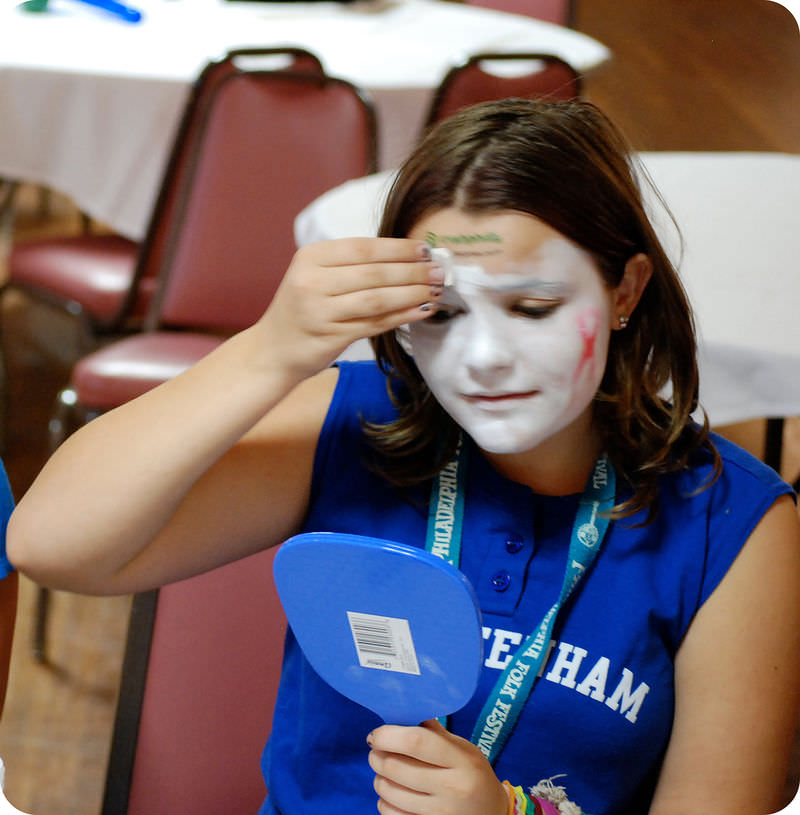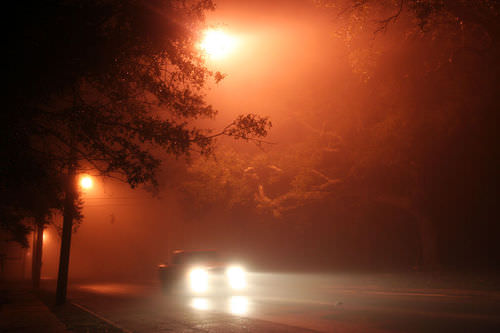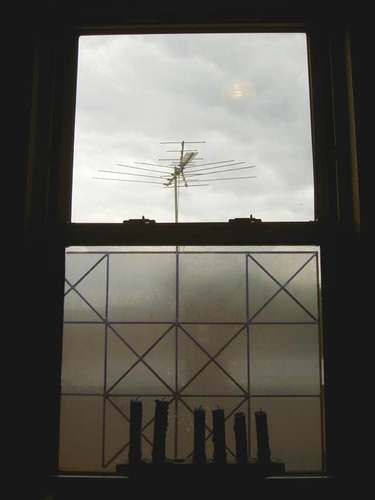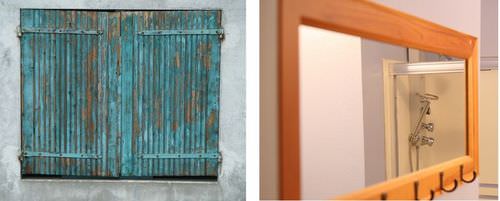19.3 可见光光和物质
章节大纲
-
A mime is an actor who uses movement and facial expressions rather than words to communicate with an audience. The mime in this picture is using a mirror to apply stage makeup that will accentuate her features so she can communicate more expressively. When light strikes a mirror, it is reflected back from the shiny surface. The reflected light forms an image of whatever is in front of the mirror. is just one way that visible light may interact with matter.
::MIME 是一个使用运动和面部表情而不是文字与观众交流的演员。 MIME 正在使用镜子来应用舞台化的化妆, 以突出她的特征, 以便她能够更清晰地进行交流。 当光照镜子时, 它会从闪亮的表面反射回来。 反光会形成镜子前的任何事物的图像。 只有一种方式, 可见的光可以与物质互动 。Reflection
::反射反射Reflection of light occurs when light bounces back from a surface that it cannot pass through. Reflection may be regular or diffuse.
::当光从无法穿透的表面反射回来时,光的反射就会发生。反射可以是正常的,也可以是分散的。-
If the surface is very smooth, like a mirror, the reflected light forms a very clear image. This is called regular, or specular, reflection. In the
Figure
, the smooth surface of the still water in the pond on the left reflects light in this way.
::如果表层像镜子一样非常光滑,反光会形成一个非常清晰的图像。 这被称为普通反射, 或直观反射。 在图中, 左边池塘中静水光滑的表面会以这种方式反映光线 。 -
When light is reflected from a rough surface, the waves of light are reflected in many different directions, so a clear image does not form. This is called diffuse reflection. In the
Figure
, the ripples in the water in the picture on the right cause diffuse reflection of the blooming trees.
::当光从粗糙的表面反射出来时,光波会从许多不同方向反射,因此清晰的图像不会形成。这被称为散射反射。在图中,图中图中图中图中图中图中图中图中图中图中水的波纹会导致开花的树木的散射反射。
Transmission
::传输传输Transmission of light occurs when light passes through matter. As light is transmitted, it may pass straight through matter or it may be refracted or scattered as it passes through.
::当光经过物质时,光的传送即发生;当光经过物质时,光可以直经物质,或者在经过时被打碎或分散。-
When light is refracted, it changes direction as it passes into a new
medium
and changes
. The straw in the
Figure
looks bent where light travels from water to air. Light travels more quickly in air than in water and changes direction.
::当光重新对开时,它会随着向向变化而演变成一个新的介质和变化。图中的稻草看似从水到空气的光向弯曲。光在空气中移动的速度比在水中更快,并改变方向。
-
Scattering
occurs when light bumps into tiny particles of matter and spreads out in all directions. In the
Figure
, beams of light from car headlights are shining through fog. The light is scattered by water droplets in the air, giving the headlights a “halo” appearance.
::当光线碰到微小的物质微粒并散射到各个方向时,就会散射。在图中,车头灯光的光束在雾中闪耀,光线被空气中的水滴散散开,使车头灯出现“光线”的外观。
Q: What might be another example of light scattering?
::问题:光散的另一个例子是什么?A: When light passes through smoky air, it is scattered by tiny particles of soot.
::甲:当光线穿过烟雾空气时,会散落在烟尘微小微粒上。Absorption
::吸收吸收Light may transfer its to matter rather than being reflected or transmitted by matter. This is called absorption . When light is absorbed, the added energy increases the of matter. If you get into a car that has been sitting in the sun all day, the seats and other parts of the car’s interior may be almost too hot to touch, especially if they are black or very dark in color. That’s because dark colors absorb most of the sunlight that strikes them.
::光可能会转移到物质上,而不是被物质反射或传输。 这被称为吸收。 当光被吸收时,增加的能量会增加物质。 如果进入日落的汽车,座位和车内其他部分可能几乎太热,无法触碰,特别是如果它们颜色是黑色或非常暗的话。 这是因为黑暗的颜色吸收了它们所遭遇的大部分阳光。Q: In hot sunny climates, people often dress in light-colored clothes. Why is this a good idea?
::问:在炎热的阳光气候下,人们往往穿着浅色衣服。为什么这是个好主意?A: Light-colored clothes absorb less light and reflect more light than dark-colored clothes, so they keep people cooler.
::甲:浅色衣服吸收的灯光较少,反映的光比深色衣服更亮,因此使人们更冷却。Classifying Matter in Terms of Light
::以轻度术语对物质进行分类Matter can be classified on the basis of its interactions with light. Matter may be transparent , translucent , or opaque . An example of each type of matter is pictured in the Figure .
::物质可能透明、透明或不透明。-
Transparent
matter is matter that transmits light without scattering it. Examples of transparent matter include air, pure water, and clear glass. You can see clearly through transparent objects, such as the top panes of the window
, because just about all of the light that strikes them passes through to the other side.
::透明物质是传递光而不散布光的物质。 透明物质的例子包括空气、纯水和清晰的玻璃。 您可以通过透明物体(如窗口的顶层窗帘)看清楚, 因为撞击它们的所有灯光都穿过另一边。
-
Translucent
matter is matter that transmits light but scatters the light as it passes through. Light passes through translucent objects but you cannot see clearly through them because the light is scattered in all directions. The frosted glass panes at the bottom of the window
are translucent.
::半透明物质是传递光物质,但随着光的穿透而散开。光通过半透明天体,但由于光分散在四面八方,你无法清楚地看到这些天体。窗底的冰霜玻璃板是半透明。 -
Opaque
matter is matter that does not let any light pass through it. Matter may be opaque because it absorbs light, reflects light, or does some combination of both.
::不透明物质不会让任何光通过它。 物质可能不透明,因为它吸收光,反映光,或者两者有某种结合。
Examples of opaque objects are objects made of wood, like the shutters in the Figure . The shutters absorb most of the light that strikes them and reflect just a few of visible light. The glass mirror is also opaque. That’s because it reflects all of the light that strikes it.
::不透明的物体是木制物体的例子,如图中的百叶窗。百叶窗吸收了大多数撞击它们的光线,只反映一些可见的光。玻璃镜子也是不透明的。这是因为它反映了撞击它的所有光。Watch the video below to learn more about how light can be used to determine the structure of matter:
::更多了解如何使用光来决定物质结构:Summary
::摘要-
Reflection of light occurs when light bounces back from a surface that it cannot pass through. If the surface is very smooth, the reflected light forms an image.
::当光从无法穿透的表面反射回来时,光的反射就会发生。如果表面非常光滑,反射光就会形成图像。 -
Transmission of light occurs when light passes through matter. As light is transmitted, it may pass straight through matter or it may be refracted or scattered by matter.
::当光经过物质时,光的传送即发生;当光经过物质时,光可直经物质,或因物质而变弱或散落。 -
Absorption of light occurs when light transfers its energy to matter rather than being reflected or transmitted by matter. The temperature of matter increases with the added energy.
::当光向物质转移其能量而不是物质反射或传输时,就会吸收光,随着增加的能量,物质温度会上升。 -
Matter can be classified as transparent, translucent, or opaque depending on how it interacts with light.
::物质可被归类为透明、透明或不透明,取决于它如何与光相互作用。
Review
::回顾-
Describe three ways that light can interact with matter.
::描述光能与物质互动的三种方式。 -
Transmitted light may be refracted or scattered. When does each process occur?
::传送的光线可能被分解或分散,每个过程何时发生? -
Why does matter increase in temperature when it absorbs light?
::为什么吸收光时温度会升高呢? -
Compare and contrast transparent, translucent, and opaque matter.
::比较和对比透明、透明、不透明的物质。
-
If the surface is very smooth, like a mirror, the reflected light forms a very clear image. This is called regular, or specular, reflection. In the
Figure
, the smooth surface of the still water in the pond on the left reflects light in this way.





